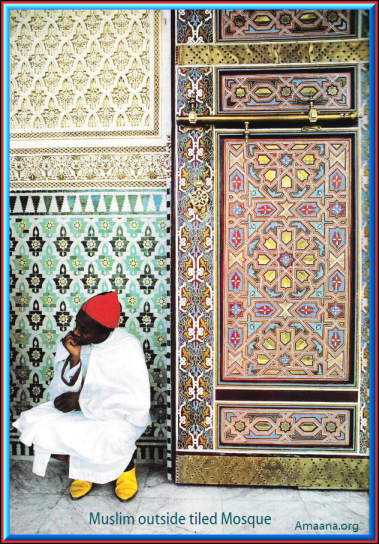
Geometry figures in older Islamic art
By Jeremy Manier, Chicago Tribune
March 1, 2007
|
The intricate abstract designs of Islamic art and architecture have always struck experts as the inspired expressions of a faith that forbids direct depictions of holy figures. But a new study shows that Muslim artisans working in what is now Iran went further, producing a sophisticated geometric pattern more than 500 years before Western mathematicians identified it in the 1970s and 1980s.
It’s unclear whether artists of the time fully understood the unique features of their patterns, which researchers at Harvard and Princeton Universities found in tile decorations on a shrine and mosque dating from the 15th century.The designs are quasi-crystalline, meaning they are predictable but do not regularly repeat themselves. They match a convoluted tiling pattern discovered in recent times by the mathematical physicist Roger Penrose, best known for his work on relativity theory.
But even if the patterns’ deepest significance eluded the artisans, experts said only people with an advanced grasp of geometry could have made such elaborate interlocking designs.
The new study, published in the journal Science, offers a window into a time when Islamic scholars were centuries ahead of their European counterparts and used their mathematical prowess to convey the holy in art.
“If the authors are right in their analysis, it’s really quite extraordinary,” said Oleg Grabar, a professor of Islamic art and architecture at the Institute for Advanced Study at Princeton. “I always knew buildings from this era were different, but I never knew the difference was in the nature of their geometry.”
For study co-author Peter Lu, a Harvard graduate student in physics, the mathematics work carries a cultural meaning now that tensions are rising between Iran and the U.S. He said it shows a tradition of inquiry that both Iranians and Americans can embrace.
“We’re talking about a branch of math that most people didn’t understand until the last 30 years,” Lu said. “That doesn’t arise in a culture that’s unwilling to have intellectual freedom.”
To make quasi-crystalline patterns, Lu believes the Iranian artisans relied on a handful of templates, called girih tiles, in the form of pentagons, decagons and other simple shapes. When arranged properly, the tiles formed a nonrepeating pattern with intriguing properties.
For example, if the tiling could be carried out infinitely, a mathematician could predict where each piece would be, even though the tile groupings would always vary.
Penrose’s discovery of quasi-crystals in the 1970s was a purely mathematical achievement, but the patterns found a practical use in the 1980s. That’s when study co-author Paul Steinhardt of Princeton and his colleagues discovered quasi-crystalline patterns in the structure of certain metallic alloys that are used in nonstick frying pans and other applications.
“Physicists were really excited about this stuff in the late 1980s,” said Joshua Socolar, a professor of physics at Duke University. “It’s fascinating that you would find these patterns in such old architecture.”
Lu said he thought of looking for quasi-crystalline patterns in Islamic art after he gave a physics lecture in the Muslim nation of Turkmenistan and toured some religious buildings there. He saw one structure with the 10-point stars and pentagons that are characteristic of Islamic patterns – and also are a hallmark of quasi-crystals.
Lu began plowing through thousands of photos of Islamic artwork with the help of Gulru Necipoglu, a Harvard professor of Islamic art and architecture. Necipoglu had published a paper on the 15th century Topkapi scroll from Iran, which contains ink drawings that served as stencils to make girih tiles.
Necipoglu said the complex geometry in art of the period trickled down from the achievements of mathematical scholars. Muslims in Baghdad had made the first translations of Euclid’s geometry in the ninth century, giving them a 200-year head start on European intellectuals and architects.
Islamic architects started “using geometry to express the holy,” said Grabar of Princeton. “It suggested something transcendental and extraordinary.”
Lu’s study of the Topkapi scroll and tile patterns on the Darb-i Imam shrine in Iran suggested how artisans could have used simple methods to make the dizzyingly complex Penrose patterns.
The artists would have started with large versions of girih tiles, then followed rules for subdividing the tiles into patterns of much smaller pieces. The rules ensured that all the tiles would fit together – and that the overall pattern would be a nearly perfect quasi-crystal.
Experts said further research might shed more light on whether anyone in the 15th century grasped the singular geometry of their creation.
“If this is all the evidence we ever get, I will remain skeptical,” said Socolar of Duke.
Yet Lu said he’s intrigued by how deliberate the rules were, suggesting in-depth knowledge of the tricky geometry of pentagons and decagons – shapes that are notoriously hard to use in tile patterns. Necipoglu said her research suggests that Islamic art and engineering often had a theoretical basis.
“If an artisan was running into a major problem decorating the king’s palace, there would have been a mathematician sitting right there,” Necipoglu said. “There’s no reason why they couldn’t have been in contact.”
Source: http://legacy.utsandiego.com/uniontrib/20070301/news_1c01tiles.html
